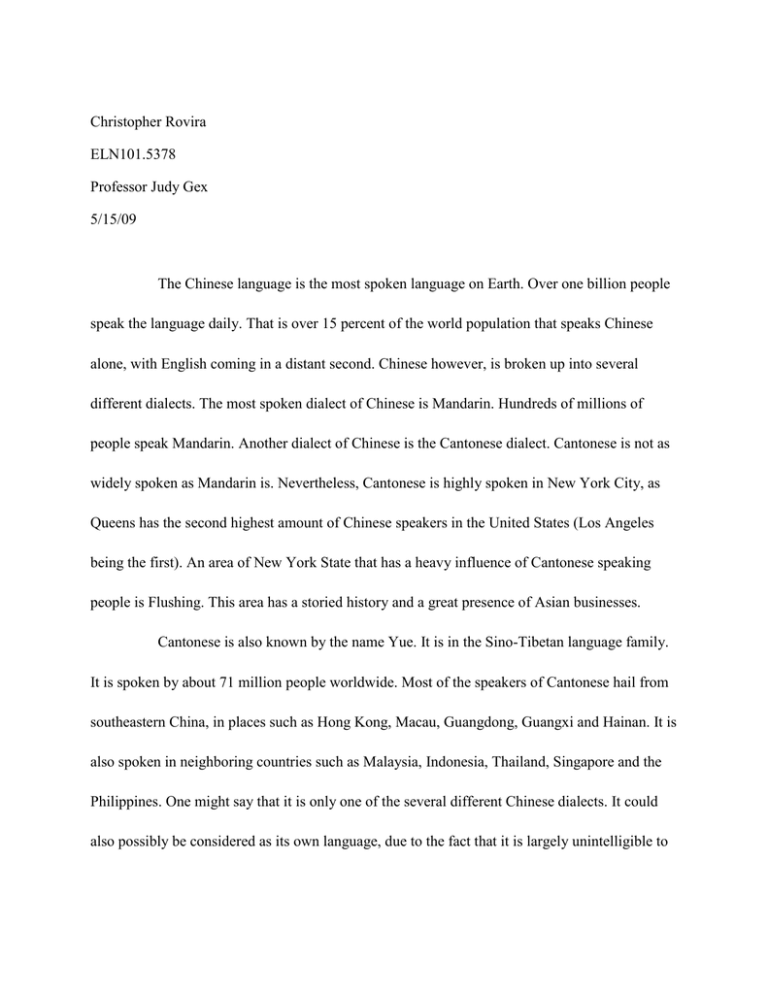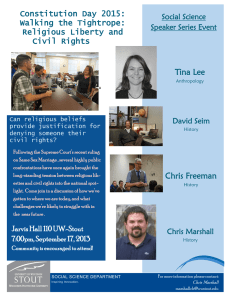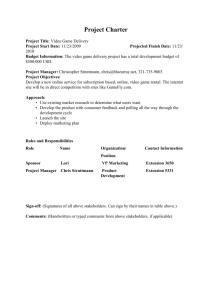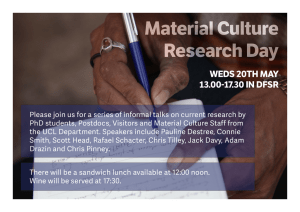Christopher Rovira ELN101.5378 Professor Judy Gex 5/15/09
advertisement

Christopher Rovira ELN101.5378 Professor Judy Gex 5/15/09 The Chinese language is the most spoken language on Earth. Over one billion people speak the language daily. That is over 15 percent of the world population that speaks Chinese alone, with English coming in a distant second. Chinese however, is broken up into several different dialects. The most spoken dialect of Chinese is Mandarin. Hundreds of millions of people speak Mandarin. Another dialect of Chinese is the Cantonese dialect. Cantonese is not as widely spoken as Mandarin is. Nevertheless, Cantonese is highly spoken in New York City, as Queens has the second highest amount of Chinese speakers in the United States (Los Angeles being the first). An area of New York State that has a heavy influence of Cantonese speaking people is Flushing. This area has a storied history and a great presence of Asian businesses. Cantonese is also known by the name Yue. It is in the Sino-Tibetan language family. It is spoken by about 71 million people worldwide. Most of the speakers of Cantonese hail from southeastern China, in places such as Hong Kong, Macau, Guangdong, Guangxi and Hainan. It is also spoken in neighboring countries such as Malaysia, Indonesia, Thailand, Singapore and the Philippines. One might say that it is only one of the several different Chinese dialects. It could also possibly be considered as its own language, due to the fact that it is largely unintelligible to Mandarin and other Chinese speakers. Cantonese originated in the Sui Dynasty of China, when people of the Han dynasty integrated with the southern Chinese living people. Most Cantonese speaking people around the world are descendants of people who lived in Guangdong or Hong Kong. In Hong Kong, Cantonese is the main form of spoken Chinese, being used in education, government and public life. Cantonese grammar is quite different from English in almost every way. In Hong Kong, colloquial Cantonese is written with a mixture of standard Chinese characters and over a thousand extra characters invented specifically for Cantonese. Cantonese is an analytic language where, in a sentence, the arrangement of words is important to its meaning. A basic sentence in Cantonese contains a subject followed by a verb and then by an object. A verb itself indicates no tense. The time can be explicitly shown with time-indicating adverbs. An optional aspect particle can be appended to a verb to indicate the state of an action. Appending interrogative or exclamative particles to a sentence turns a sentence into a question or shows the attitudes of the speaker. Cantonese verbs are marked for aspect rather than tense. Tense is specified through the use of time adverbs. Additionally, verbal complements may show aspectual distinctions, indicating whether an action is just beginning is continuing, or at completion, and also the effect of the verb on its object. Aspect particles are treated as suffixes bound to the verb. The aspect particles are perfective, experiential, progressive, durative, delimitative, habitual, inchoative and continuative. Cantonese uses the following pronouns, which like in many other Sinitic languages, function as both subjective and objective: ngo (1st person singular), nei (2nd person singular), keoi (3rd person singular), ngo dei (1st person plural) nei dei (2nd person plural) and keoi dei (3rd person plural). For possessives, singular nouns use the word ge, which is the same as using an apostrophe s. Plural nouns use the word di. Possessive pronouns are formed by adding ge or di after the pronoun. One of the most populated cities in New York when it comes to Chinese people is Flushing. Flushing is located in the borough of Queens, which has the second highest amount of Chinese speakers in the United States. Flushing is located in north-central Queens surrounded by Maspeth and Whitestone. It is one of the wealthiest cities in New York. It also has one of the busiest shopping districts in Queens. Both Northern Boulevard and Main Street are the most active when it comes to business. There are many Chinese companies in Flushing, ranging from banks, to medical offices, to jewelry stores. One of the most populated areas in New York when it comes to Chinese people is Flushing. Flushing is located in the borough of Queens, which has the second highest number of Chinese speakers in the United States. Flushing is located in north-central Queens surrounded by Maspeth and Whitestone. It is one of the wealthiest cities in New York. It also has one of the busiest shopping districts in Queens. Education wise, Flushing is ahead of most other areas in New York State, as it has one of the biggest branches of the Queens Borough Public Library and also is home to the City University of New York’s Queens College. In addition, both Northern Boulevard and Main Street are the most active when it comes to business. There are many Chinese companies in Flushing, ranging from banks to medical offices to jewelry stores. Besides this, Flushing also has a storied history that dates back to the times of the early colonial days. This makes Flushing one of the most renowned areas in all of New York. The history of Flushing is quite long and illustrious, and somewhat differs from how it looks today. Flushing was founded in 1645 and was originally one of the first Dutch settlements on Long Island. Today, it is one of the largest and most diverse neighborhoods in New York City and has expanded well beyond its original boundaries. Flushing's diversity is reflected by the numerous ethnic groups that reside here including people of Asian, Hispanic, European and African American decent. In 1664, the English took control of the area, ending Dutch control of the colony, and renamed it New York. Flushing remained a small Long Island village. In the American Revolution during the last half of the 18th century, Flushing favored the British side and housed British troops. By the mid-1860s, Queens County had 30,429 residents. Flushing's expansion continued in 1867 and 1868 when the neighboring villages of College Point and Whitestone were incorporated into Flushing. In 1898, although opposed to the proposal, Flushing was consolidated into the City of New York. Local farmland continued to be subdivided, transforming Flushing into a densely populated neighborhood of New York City. The continued construction of bridges over the Flushing River and the development of other roads increased the volume of vehicular traffic into Flushing. In 1909, the construction of the Queensborough Bridge over the East River connected Queens to midtown Manhattan. The 1939-1940 World's Fair and the 1964-1965 World's Fair were held at Flushing Meadows Park. This sums up the major events in the history of Flushing. Education in Flushing is also a main factor in the city. In 1858, the first library in Queens County was founded in Flushing. Today, there are eight branches of the Queens Borough Public Library with Flushing addresses. The largest of the Flushing branches is located at the intersection of Kissena Boulevard and Main Street, and is the busiest library in the country. This library has developed into a valuable community resource and houses an auditorium for public events. Queens College, founded in 1937, a senior college of the City University of New York is located between Kissena Boulevard and the Long Island Expressway. Queens College is known for its reputation as one of the better college programs in New York City. It is also known for its beautiful and huge campus. These institutions help shape Flushing into an important city. Presently in Flushing, the look of the city is much different. The intersection of Main Street and Roosevelt Avenue, the business center for Flushing located on the westernmost edge of the neighborhood has a concentration of Chinese small businesses. This area is known for its selection of authentic Chinese food and other Asian restaurants. Chinese-owned businesses in particular predominate in the area along Main Street and the immediate area west of it. As one of the highest retail centers in New York City, Flushing is crowded with banks competing for customers. Many Chinese immigrants have settled in Flushing in the past decade. In response to this, many Asian-American banks have opened up to compensate for the increase in the Asian population. These banks have been competing against larger banking corporations such as Citibank. These banks are preferred over the American ones because they find a closer relation and shorter lines in these Chinese-American banks. Due to Flushing becoming home to many Cantonese speaking people, these banks continue to thrive and prosper. In my study of the Cantonese language, I interviewed three people with different histories pertaining to the dialect. Each of these people came from relatively different generations and has both similarities and differences compared to each other. The three people I interviewed are: Linda Du, a 16 year old friend of mine, Bin Ye, a 20 year old friend from high school, and Jill Qu, a 27 year old friend from LaGuardia. They all share different experiences with me, most closely related to the age difference. What I noticed was that Linda, who is the youngest and has lived in New York the longest is more “Americanized” compared to Bin and Jill. This is shown with the interview questions that I asked them. I asked them all the same questions to show the differences between each other. Linda Du is a 16 year old sophomore currently enrolled in Forest Hills High School. She is a coworker of mine at the job I currently work at. She lives with her mother, father, grandmother, grandfather and has a younger brother. Her original Chinese name is Ling-Ling Du. From what I observed, she had the least influence from Cantonese, but still held on to some traditions her parents have kept observing. Here is the interview I conducted with Linda. Chris: What languages do you speak? Linda: I speak English and Chinese, Cantonese dialect. Chris: Roughly how often do you speak Chinese per day? Linda: About only one-third of my day. Chris: How long have you lived in the United States? Linda: 12 years. Chris: What traditions have you kept that is different from most American traditions? Linda: Well, we eat dinner together as a family every night at the same table. For us, it is a priority to eat together; we are not allowed to eat in our rooms. Another tradition is my family keeps this cabinet in our house with statues of 3 gods. One of the statues is a holy lady that’s super white. On certain days, my grandmother would cook food for the goddess and place it in front of it and pray to it. That night we would eat the food. Chris: What do you believe your native language to be? Linda: English. Chris: Do you see a change in the newer generation and the way they speak that is different from the old way? Linda: Yes, the kids speak less Chinese outside of their homes. They treat Chinese like it’s a second language to them. The older generation only tends to speak to Chinese people. Chris: Which language do you prefer speaking? Linda: English. Chris: What language do you speak at home? Linda: Both. Chris: How did you adjust to learning English? Linda: Learned from school, from kindergarten on. Chris: Which language did you learn first? Linda: Chinese. Chris: Where in China were you originally from? Linda: Hong Kong. Chris: Why did your parents come to New York? Linda: My parents were not making as much money as they used to in China, so they moved to the U.S. Also, it was to give me and my brother better opportunities to get an education and to live a better life. Chris: What do you like about China that you don’t really like here? Linda: The weather is a lot nicer there. The weather is warm most of the time; it doesn’t get too cold there. Also I love the food there, it is so exotic. Chris: What do you like about here that you don’t like in China? Linda: I don’t like that all the people there are so loud. They talk way too much. Seriously, it gives me such a headache! Chris: Can you explain what it is like in your hometown? Linda: It’s a big city; it’s kind of fast paced. It sort of reminds me of New York. At night the lights are so bright. And in the river there were boats that the tourists would go on, and the boats would be colorful and bright too. The whole city was bright and colorful too. Chris: What types of houses and buildings did they have there? Linda: There were really tall buildings. I lived next to a river and across from that river was the city. Chris: Are you glad you came to this country? Linda: Yes, because this place has such a nice environment and it is so diverse with many cultures. It is an exciting place and great people live here. Chris: What is your most memorable moment in China? Linda: It’s probably when stepping off the airplane at the airport, reuniting with my family and relatives that live there. It was an emotional moment. Bin Ye is a 20 year old friend of mine that went to the same high school as I did. We both attended Aviation High School. He is currently attending Stony Brook University and is dorming there. While not at the college, he lives with his parents, grandparents, and older sister. Although he spent about half his life here, it seems he is more in tune with his heritage than Linda is. This is probably due to the fact that he was ten years old when he came to this country, while Linda was only four. Here is the interview that I got from Bin. Chris: What languages do you speak? Bin: Both Chinese and English, Cantonese, Mandarin and Wenzhou dialects. Chris: Roughly how often do you speak Chinese per day? Bin: Half of my day. Chris: How long have you lived in the United States? Bin: 10 years. Chris: What traditions have you kept that are different from most American traditions? Bin: We eat dinner together as a family; most Americans only eat by themselves. Also, we celebrate Chinese New Year. Chris: What do you believe your native language to be? Bin: Chinese Chris: Do you see a change in the newer generation and the way they speak that is different from the old way? Bin: The younger generation is more informal and uses a lot of slang. The older generation speaks more formal, more mature and more professional. Chris: What language do you prefer speaking? Bin: I have no preference; I don’t mind speaking either language. Chris: Which language do you speak at home? Bin: Chinese. Chris: How did you adjust to learning English? Bin: Listening to people speak and speaking to back to them. I learned most of my English in school. Chris: Which language did you learn first? Bin: Chinese. Chris: Where in China were you originally from? Bin: I lived in Southern China in the Zhejiang province. The city is called Wenzhou. Chris: Why did your parents come to New York? Bin: It was to achieve more opportunities for me and my sister. Chris: What do you like about China that you don’t really like here? Bin: Since I came here I have been slacking in school. In China that would not happen, they are stricter about education. You had to pay for your school there, here its free up until college. Chris: What do you like about here that you don’t like in China? Bin: I like that there are more opportunities here than in China. There are too many people in China, there are very limited opportunities. Chris: Can you explain what it is like in your hometown? Bin: It’s a village, where everyone knows everyone. Chris: What types of houses and buildings did they have there? Bin: Concrete and some wood houses. Chris: Are you glad you came to this country? Bin: I am glad, because I learned English and learned to live in a democratic country. There are so much more opportunities and free rights. Chris: What is your most memorable moment in China? Bin: Going to elementary school and receiving numerous awards for good academic standing. Jill Qu is 27 year old friend of mine that also attends LaGuardia Community College. She works as a waitress in Manhattan. Her parents are still back in China, and she lives here with her older sister. Her name is originally Jiele, but she likes to be called Jill, because it’s easier to pronounce. Since she came to this country at an older age and has lived here fewer years compared to Linda and Bin, she is more in touch with her nationality than they are. I learned a lot from my interview with Jill, as she went through some amazing experiences in her lifetime so far. I also learned that both her and Bin came from the same province and city! Here is the interview I conducted with Jill. Chris: What languages do you speak? Jill: English and Chinese, Wenzhou and Cantonese dialects. Chris: Roughly how often do you speak Chinese per day? Jill: I speak Chinese everywhere. Only place I don’t speak it is at school and work. Chris: How long have you lived in the United States? Jill: 7 years Chris: What traditions have you kept that are different from most American traditions? Jill: I love reading Chinese philosophy. I’ve tried reading American philosophy, but it’s just too confusing. I always lose myself in reading books. Chris: What do you believe your native language to be? Jill: Chinese Chris: Do you see a change in the newer generation and the way they speak that is different from the old way? Jill: In the past, there used to be more traditional Chinese words. It used to be a lot more complicated. Now the Chinese is simpler. Sometimes you can’t really understand someone who is using the traditional way. My parents knew how to read it traditionally, I never learned how. Chris: What language do you prefer speaking? Jill: Chinese Chris: Which language do you speak at home? Jill: Chinese Chris: How did you adjust to learning English? Jill: I got it mostly from interacting with customers at work. I also learned English from hearing people’s conversations. Chris: Which language did you learn first? Jill: Chinese. Chris: Where in China were you originally from? Jill: The state I lived in was called Zhejiang. The city I lived in was Wenzhou Chris: Why did you come to New York? Jill: When I was still in China I never thought of coming here. I had my future all planned out in China. I was forced to stop school there. I believe though it is better to come here to continue school. Chris: What do you like about China that you don’t really like here? Jill: Chinese life is more colorful and more relaxed. In China I could always find people to hang out with. Here there is no time to relax because of going to school, and having to work. Chris: What do you like about here that you don’t like in China? Jill: The people here are more independent than in China, especially when it comes to school. There it is much stricter when it comes to education. Chris: Can you explain what it is like in your hometown? Jill: It was on a small island. It was very beautiful. When you wake up in the morning the air is very, very, fresh. It is very peaceful there and everyone is friendly. Chris: What types of houses and buildings did they have there? Jill: Everyone had their own house and land. Pretty much every house had its own front and back garden. Chris: Are you glad you came to this country? Jill: I’m not really glad because I had my future planned in China. I am happy that I can experience living here and finding a chance to live life here. Chris: What is your most memorable moment in China? Jill: One of the most painful memories I had was when I had to stop my schooling in China because my father’s company closed down. It all happened so suddenly, I couldn’t believe what happened. It was like when I first came here I had to start all over again. I do appreciate the experience though. One of the happiest memories I had was when I was 11 years old. My parents would always leave me and my sister alone at home while they went off on business. Sometimes they would be gone for a whole year. When me and my older sister were at home, suddenly the whole city was flooded. To survive, we went on top of the roof of our neighbor’s house, which was higher than our house. Our whole house was underwater when this happened. The next day my parents came back from their business trip. When we saw them, it was the happiest moment of my life. I learned so much from research of the Cantonese dialect, the history of Flushing and my interviews with Linda, Bin and Jill. I learned about the history, grammar and rules of Cantonese. I also learned a lot about the history of Flushing and how it has evolved into a financially strong area today. Where I learned most was from the interviews. I noticed that the older they were the more in touch they were with their culture. I learned from Linda that even though she has a Chinese background, she says her native language is English. One major thing that I learned was that in China, kids could be left alone to live by themselves for years at a time, and Jill told me that was normal there. That would never happen here, if a parent did that they would probably be arrested here. This research has broadened my understanding of Cantonese and the culture associated with it.




